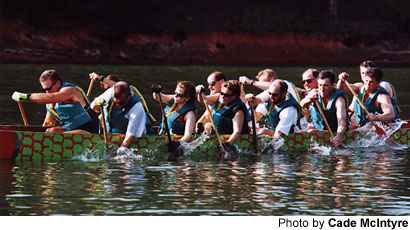
May 16, 2000 — Back. Arm. Shoulder. Side. Backside. Legs.
Did I say back?
Perhaps it would be easier to list the parts of my body that weren’t sore after my first dragon boat paddling practice less than two weeks ago:
There.
You see, all the right parts were sore, but so too were most of the wrong parts. 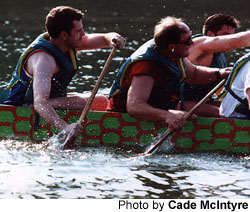
My stroke was bad at the beginning of practice and poor at the end. But that was to be expected, I was told.
“There is a learning curve, and it doesn’t come as easy as you might think,” admitted Richard Stokes, who captains the AT&T Dragoneers — my team for this Saturday’s Hong Kong Dragon Boat Festival of Atlanta on Lake Lanier.
“The technique is not what you would choose to do if you just sat down in a boat. It’s not intuitive, but it’s logical.”
Logical? I think I was absent the day we learned dragon boating in high school gym class.
You too? Well, just in case, here’s a little background for those not down with the dragon.
The Internet purports dragon boat racing — which dates back to China circa 400 B.C. — to be the oldest continuously-raced sport in the world. With more than one million teams competing worldwide today, dragon boat racing is the second most popular sport on Earth.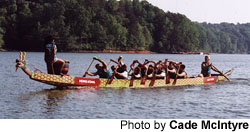
Who knew?
All of the furor is focused on a 40-foot wooden canoe with a carved dragon tail and head affixed to stern and bow. The boat seats 20 uncomfortably: steerer and drummer occupy either end, while 18 paddlers punch their paddles into the water in unison at more than 80 strokes per minute.
No, I am not my team’s drummer. Not yet, at least. But the pressure is on.
Stokes’ Dragoneers have won the Atlanta race — a qualifier for August’s nationals in New York City — all five years of its existence. No doubt who the paddles will be pointed at if this year’s outcome is not the same.
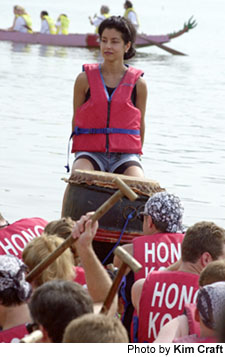 And the drummer’s seat at the front of the boat is taken — so there can be no demotion for me. More of a hood ornament than a rhythm keeper anymore, Dragoneers drummer Parisa Johnston likes her vantage point just fine.
And the drummer’s seat at the front of the boat is taken — so there can be no demotion for me. More of a hood ornament than a rhythm keeper anymore, Dragoneers drummer Parisa Johnston likes her vantage point just fine.
“When I see the pained expressions on the paddlers’ faces,” Johnston said, “I’m happy to be sitting right where I am.”
Today marks my fourth practice with the team, and I am still trying to get sore in all the right places, still trying to master — or, if nothing else, mimic — the proper stroke.
At least there are others in the same boat, so to speak. Ethan Johnson, a rowing coach at Georgia Tech and another Dragoneer rookie, rubbed his shoulder and winced a bit after practice No. 1.
“It’s definitely different,” said Johnson, 24. “In rowing I’m used to a lower stroke rate, a different technique. This is like learning to ride a bike all over again.”
(By the way, in my 20 months writing this column, I have learned that any new athletic skill is no doubt analogous to learning how to ride a bike.)
Stokes likens the dragon boat stroke to chopping ice, which is an equally foreign science to me.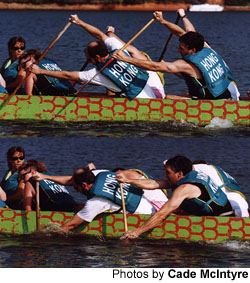
The body leans forward, almost out of its seat, with the outside leg supporting the brunt of the weight. The outside arm remains straight and reaches forward, gripping the paddle right above its blade. The inside arm, clutching the top of the paddle’s handle, remains raised at the shoulder, and rotates back and forth, up and down, providing the force behind the blade’s entry into the water.
Again and again.
Hundreds of times in one 250-, 500- or 1,000-meter race.
“The shoulder is not used to that for two to four minutes in a row,” said Stokes, 47, of Ball Ground. “That causes a lot of pain for most people.”
 But dragon boating seems to attract those with a penchant for pain. For example, one Dragoneer just finished racing his 50th marathon and plans to run a 50-miler in Africa soon. Stokes, a member of the Lake Lanier Rowing Club’s racing team, recently competed in the Blue Ridge Mountain Adventure Race and once tried out for the television show “American Gladiators.”
But dragon boating seems to attract those with a penchant for pain. For example, one Dragoneer just finished racing his 50th marathon and plans to run a 50-miler in Africa soon. Stokes, a member of the Lake Lanier Rowing Club’s racing team, recently competed in the Blue Ridge Mountain Adventure Race and once tried out for the television show “American Gladiators.”
And there’s no questioning Stokes’ dedication to dragon boat racing, either. Since the actual boats used in the race — authentic models from China — are only made available to the teams two weeks prior to the festival, Stokes took matters into his own hands. He bought a quarter ton of lumber and constructed the Dragoneers’ practice boat himself.
“Yeah, that’s probably a little out there,” Stokes said, grinning sheepishly.
But Stokes’ extremism is appreciated and, in my case, necessary.
Only two more practices to go before race day. And I need every last one of them.
